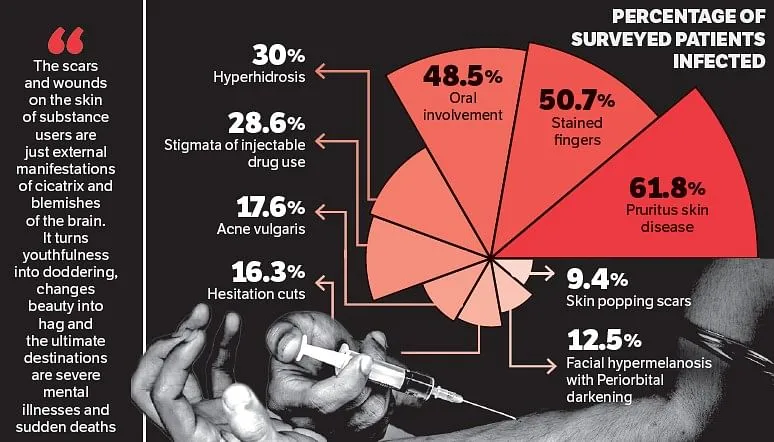Srinagar: Afaq Manzoor (name changed), 23, developed scars on his body following years of substance abuse.
He wanted to get rid of these scars and stopped consuming drugs for some time. However, after some days, he could not resist and got back to old habits.
Substance abuse did not only affect his internal organs but damaged his skin too.
Like Afaq, hundreds of youngsters in Kashmir have developed different dermatological manifestations due to substance abuse.
The spike in wounds among the people who use drugs in Kashmir presents a grim picture. According to the recent study, ‘Prevalence and pattern of dermatological manifestations among substance users across Kashmir in north India’ conducted by a senior resident Dr Aquib Aslam at GMC, under the guidance of Dr Arshad Hussain, a professor at the Institute of Mental Health and Neuroscience (IMHANS), dermatological manifestations are quite prevalent among substance users in the population of Kashmir.
The study included a total of 710 cases with 657 males (92.5 percent) and 53 females (7.5 percent).
The male-female ratio was 12.4:1 and the mean age of patients was 25 years.
As per the study, at least 61.8 percent of patients were infected with Pruritus skin disease, 50.7 percent had stained fingers, and 48.5 percent of young patients were infected with oral involvement (periodontal disease, thrush, stomatitis nicotinica, black hairy tongue).
Also, 30 percent of substance-abuse patients were found to be infected with Hyperhidrosis, 28.6 percent had stigmata of injectable drug use (track marks and sooting tattoos), 17.6 had Acne vulgaris, Hesitation cuts were found in 16.3 percent patients, Facial hypermelanosis with Periorbital darkening in 12.5 percent patients, 9.4 percent patients were infected with skin popping scars.
Prurigo were found in 8.5 percent patients, Frictional callosities in 5.8 percent patients, Skin ulcers and Skin and Soft Tissue Infections (SSTI) in 5.8 percent substance abusers, Pityriasis capitis in 3.7 patients, Hand eczema were found in 3.3 percent substance abusers, Puffy hands in 2.7 percent patients, Dermatophytosis in 2.1 patients, Dermatitis artefacta in 2.1 percent patients, and others (Eczema, Psoriasis, Vitiligo) were found in 2 percent substance abusers.
“Pruritus with temporal relation to substance use, stigmata of injectable drug use including track marks and sooting tattoos, atrophic scars at injection sites, active skin ulcers, and skin and soft tissue infections, and hyperhidrosis are among important dermatological clues for detecting substance use. Recognition of such cutaneous signs is important in these cases for more effective diagnosis and treatment. Creating awareness regarding such manifestations and their probable association with substance use is also imperative,” the study revealed.
It found that 49.4 percent of patients were polysubstance users while 50.6 percent of patients used a single substance only.
Opioids were the most common substance used, among which heroin had the highest number of cases, while cannabis was found to be the second most common substance (47 percent).
Tramadol (18.9 percent), codeine (3.7 percent), and tapentadol (1.8 percent) were the other opioids used.
Among heroin users, 42.3 percent were Injectable Drug Users (IDUs) while in the rest of the cases heroin was perpetuated by smoking (57.7 percent).
Smoking was also the mode of substance abuse among all patients of cannabis use in this study (100 percent).
Talking to Greater Kashmir, Dr Arshad Hussain who wrote the Drug De-addiction Policy for J&K and is also the co-author of the paper said, “The scars and wounds on the skin of substance users are just external manifestations of cicatrix and blemishes of the brain. It turns youthfulness into doddering, changes beauty into hag and the ultimate destinations are severe mental illnesses and sudden deaths.”
Senior Resident at Government Medical College (GMC) Dr Aqib Aslam told Greater Kashmir that most of the skin diseases were found among the heroin drug users and among those who consume cannabis.
“After visiting different drug-de addiction centres including Rehabilitation centres in different districts like Srinagar, Anantnag, Baramulla and other centers. Many substance abusers were found to have diseases. These scars and ulcers are the signs of drug abuse. Even if patients do not disclose them, dermatologists get to know some skin diseases which affect people due to drug abuse,” he said.






